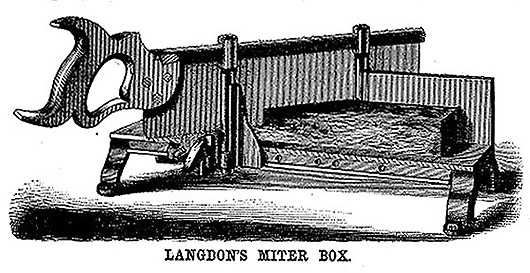Workers in wood are continually annoyed by the
disarrangement and un-reliableness of the common and temporary
miter box; the engraving shows one of more durable material than
wood, one which cannot warp or wear.
It is made entirely or
iron, yet by a simple arrangement of the parts the saw teeth
never come in contact with the metal.
It will saw four, six, and eight square, and at
any angle, from 45 to 90, the work always being done with
perfect accuracy, requiring no paring of joints with plane or
chisel, as is so often the case with that done with the common
wooden box.
The saw passes through two upright guides, that
at the back capable only of being lifted to accommodate the
thickness of the piece to be sawed, and also of turning to guide
the saw at any angle, while the front one in addition turns in a
sliding clamp which can be secured at any required point by a
dowel pin and a thumb screw.
The box is planed, both floor and back, so that
it is perfect. The saw is sustained in the guides by its back
so that under all circumstances the teeth are kept clear of
iron.
This device will recommend itself to all
practical workers in wood as durable and exact. It was patented
Nov. 24, 1864.
For machines or information address William H.
Todd, agent for the Langdon Miter Box Company, Northampton,
Mass.

Scientific American, Vol. 16, May 11, 1867,
(New York, N. Y.: Munn & Co.)
Related Info
Wiktor A. Kuc
February, 2012
We want to hear from you - write to:
info@wkFineTools.com